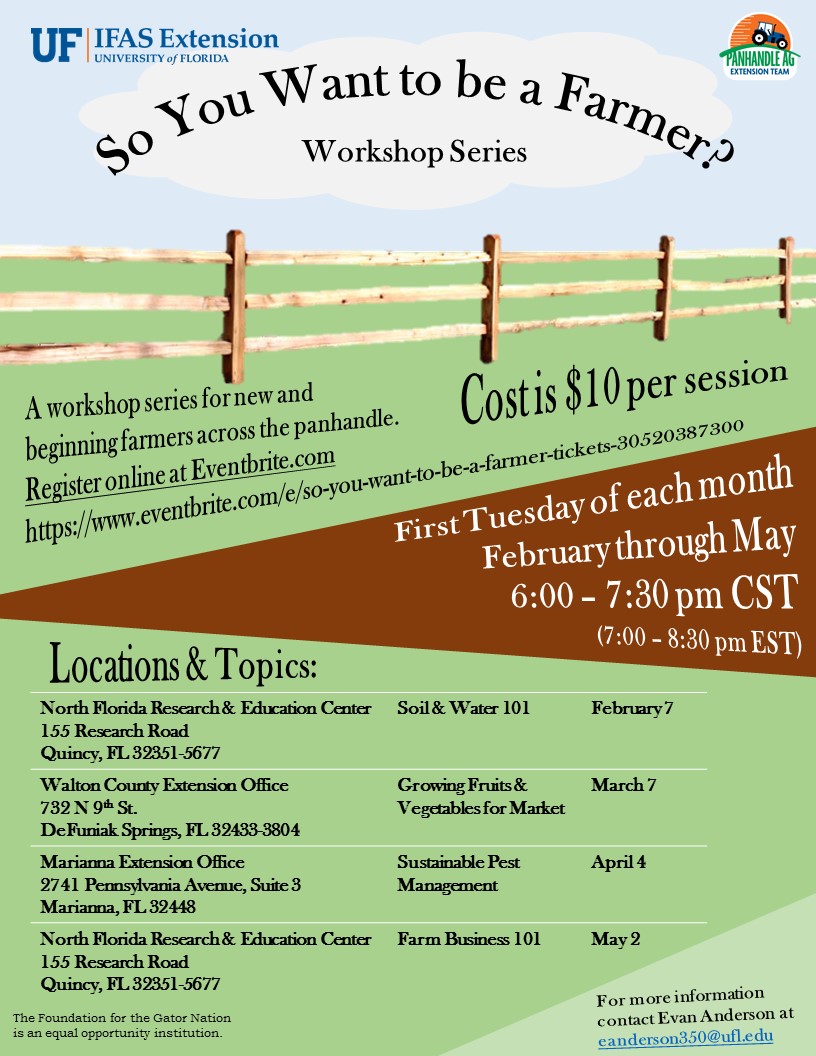
by Molly Jameson | Jan 26, 2017
Are you an avid gardener and looking to step it up a notch? Are your gardening eyes bigger than your dinner plate? If you have ever considered selling your bounty for market, you will certainly need to do your homework! One such step you can take is to attend the UF/IFAS Panhandle Extension Team’s So You Want to be a Farmer? Workshop Series.
There’s a lot to know if you want to get into this business! This series aims to introduce new or potential farmers to innovative and environmentally safe production practices, concepts of soil and water management, integrated pest management, how to grow for a farmers’ market, and farm financial management.
Agricultural professionals are actually in high demand. There is an estimated 60,000 highly skilled jobs in agriculture available annually, but only about half of these positions are being filled by graduates in agricultural fields. Additionally, Florida’s farmers are an aging group, and there was an 8% decrease in the number of farms and 26% decrease in acres of cropland from 2002 to 2012.
Fortunately, demand has greatly increased in recent years for locally produced specialty crops, meats, and dairy. There has also been an increase in the number of direct marketing opportunities and small farmers have been able to adopt new technologies, such as season extension techniques and local online marketing, to generate more revenue on small acreages.
The UF/IFAS Extension Panhandle Agriculture Team is hosting the So You Want to be a Farmer? Workshop Series to assist beginning or novice farmers as they navigate the many challenges of getting started.
If you are interested in attending, please register on the So You Want to be a Farmer? Eventbrite page. The cost is $10 per session, with sessions at multiple locations within the east Florida Panhandle.
Please see workshop dates and further details below:

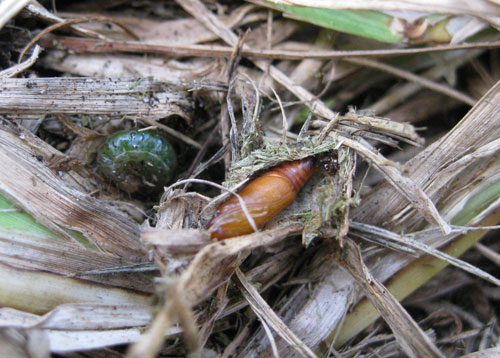
by Matt Lollar | Sep 29, 2016
Tropical sod webworms (Herpetogramma phaeopteralis) have recently been encountered in a number of yards in the Panhandle. The worms usually feed in large groups and unfortunately, the first, and basically the only, sign of damage is often a large area of shorter grass due to their feeding. The arrival time of sod webworms is also unfortunate because they are part of a group of caterpillars that successively attack turf including fall armyworm (Spodoptera frugiperda), striped grass loopers (Mocisspp.), and the fiery skipper (Hylephila phyleus).
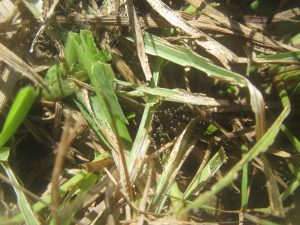
Sod webworm feeding damage in the turf thatch layer. Photo Credit: University of Florida/IFAS Extension.
Description
Larvae
Caterpillars are light yellow to orange with brown spots on each body segment and they have a dark, orange-brown head. They will grow to a full length of slight less than 1/2 inch.
Pupae
The reddish brown pupae are about about 1/4 inch long. The pupae are typically found in the upper thatch layer.
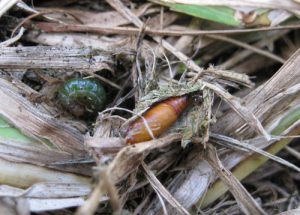
Pupa found in cocoon in St. Augustinegrass thatch. Photo Credit: Steven Arthurs, University of Florida/IFAS
Adults
The moths brown with splotchy wings and are about 3/4 inch wide.
Control
Sod webworms are difficult to control because of their spontaneity. However, in the lawn they hide in the thatch during the heat of the day. Over watering and fertilization can increase the amount of thatch. It is important to follow UF/IFAS guidelines for home lawn management.
The first line of defence is healthy turf. Proper fertilization, irrigation, and mowing height can decrease susceptibility of turfgrass against sod webworm. Over-fertilization is a common cause of caterpillar outbreaks in lawns. Cultural practices such as thatch removal by vertical mowing can help eliminate populations. Eggs are laid on grass blades and removal of grass clippings might also reduce populations.
Numerous chemical control options are available, but softer chemicals such as insecticides containing the bacteria Bacillus thuringiensis are recommended as a first line of defense. Insecticides should be applied in the morning or evening during feeding time. For additional control strategies and basic information please visit the UF/IFAS Sod Webworm Publication.
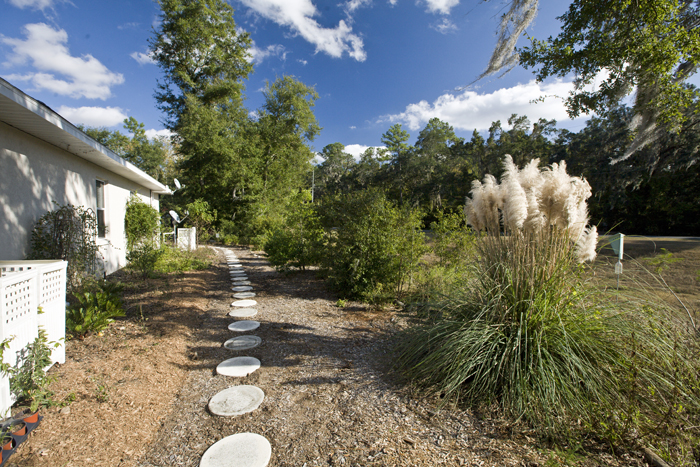
by Carrie Stevenson | Jul 19, 2016

Florida home and yard. Home, house, stone pavers, walkway, yard, landscaping. UF/IFAS Photo: Tyler Jones
Dr. Ramon Leon, Extension Weed Specialist, West Florida REC, Jay
Last year the International Agency for Research on Cancer (IARC) of the World Health Organization (WHO) classified glyphosate as “probably carcinogenic to humans.” This generated a lot of controversy because the Environmental Protection Agency (EPA), the European Food Safety Authority, and recently a joint report between the Food and Agriculture Organization (FAO) and WHO concluded that glyphosate is unlikely to be carcinogenic in humans.
As a University of Florida/IFAS Weed Specialist, I have been receiving multiple phone calls and e-mails from homeowners, homeowner associations (HOA), lawn care companies and contractors, municipalities, and county managers requesting a list of herbicides that are “safer” than glyphosate. When I ask them the reason for this particular preference, all of them acknowledged that their concern originated from hearing about the IARC report.
The first point that I always explain to people concerned about this issue is that most of the scientific evidence indicates that glyphosate does not have a higher carcinogenic risk compared to many other substances that they are normally exposed to in their daily activities. The second point is that it is important to continuously monitor how chemicals we use affect our health and the environment in the long run. The IARC report is a reminder that we should keep a close eye on glyphosate, the most widely used herbicide in the world, but it is not necessarily a call to stop using it, because at this point there is no direct evidence that it causes cancer in humans.
Very frequently, regardless of the technical details, many homeowners and citizens in urban areas are considering not using glyphosate in their gardens and landscapes, and they would like to use “safer” herbicides.
What do you mean by “safer?”
If you mean lower risk as a carcinogen, then most herbicides registered for use in urban areas would be acceptable because none of them are considered “probably carcinogenic” by IARC or any other regulatory agency. Therefore, you have multiple options to choose from. However, many of the conversations have lead to the statement, “No, I want something that is less toxic than glyphosate!”
Toxicity in pesticides is predominantly assessed using the lethal dose 50 (LD50), which indicates the amount of a chemical that kills 50% of a reference population of test animals (e.g. mice, rabbits, rats). When the LD50 is high, this means that the chemical has low toxicity, and when the LD50 is low it is considered that toxicity is higher because small amounts of the chemical can cause mortality. Glyphosate has one of the highest LD50s for herbicides. In other words, glyphosate is one of the least toxic herbicides available based on the LD50 standard. Therefore, if we want an alternative herbicide that is less toxic, we do not have any options for urban areas.
What about organic herbicides?
Many people associate “organic” with “safer.” This can be misleading because it depends on how safety is measured. For example, there are multiple organic herbicides that are considered to have the same or even higher toxicity when compared with glyphosate, because many of them have irritant and corrosive properties. Furthermore, organic herbicides have dramatically different herbicidal properties that make them unlikely alternatives to effectively replace glyphosate.
Glyphosate has one of the broadest spectrums of control, so it kills many different weed species effectively. Also, glyphosate works systemically. This means that it is absorbed by leaves and then moves inside the plant to growing points, roots, and other propagating structures. This systemic effect increases the ability to kill relatively large plants. In contrast, the majority of organic herbicides have a contact effect, so they only kill the tissue they touch without being able to move inside the plant. Therefore, they are effective at killing very small plants (<2 inches tall). Large plants can suffer leaf burning after treatment with organic herbicides, and if the application is done properly, the user will see a lot of control shortly after the application (Fig. 1). However, the plants will soon recover and the control level will decrease because, unlike plants treated with systemic herbicides, they can produce new growth from tissues that were not directly expose to the herbicide.
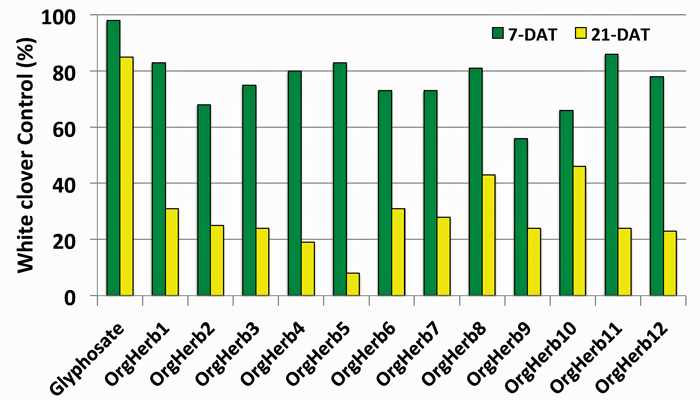
Figure 1. White clover (4 inches tall) control after treatment with glyphosate and twelve different organic herbicides based on natural oil extracts from plants. The green bars represent the level of control 7 days after treatment (DAT) and the yellow bars indicate control 21 DAT.
Considering the lack of alternatives to replace glyphosate, if you want to stop using this herbicide, and you do not want to use any other synthetic herbicides, because their toxicity might be higher, then you need to recognize that weed management will be more challenging. It is unfair to ask lawn care companies or members of HOAs to stop using the tools they have to control weeds and yet expect “weed free” lawns, gardens, and landscapes. Controlling weeds in these scenarios without glyphosate and other synthetic herbicides will require more intensive use of mechanical control approaches and hand weeding. Also, if relying on organic herbicides, these herbicides will have to be frequently applied (probably once or twice a week) in order to kill the weeds at the right time (before they get too big). Also, all these activities will increase weed control costs and the results will likely be not as satisfactory. Thus, you might end up paying more to have lawns and landscapes that will have more weeds escaping control. If this is not acceptable to you, then you probably should be more open to consider the weed control tools we have available. Also, you should be more vigilant about what are the appropriate ways to use them to minimize their risks to humans and the environment, while obtaining the benefits that you are seeking. Otherwise, you should get used to seeing more weeds in the landscape, and to be fair… this might not be as bad as some people think.

by Daniel J. Leonard | Apr 27, 2016
People are, by nature, skeptical. Humans are and have always been questioners of the world around them and that’s a good thing! For instance, when one reads a sensational article on Facebook or watches an infomercial selling a too-good-to-be-true product he/she is immediately dubious of the veracity of the claim. Given this innate sense, why do consumers take plant tags displayed on retail plants and the information listed there as infallible fact when in reality they are often full of hyperbole and misleading?
I do not mean to insinuate that nurseries and landscape professionals are intentionally leading consumers astray. They are not. However, there is much incorrect information disseminated to consumers by the green industry on plant fact sheets. Take my titular example, ‘Little Gem’ magnolia is widely advertised and sold as a “dwarf” magnolia, only growing 15’-25’ tall. If given proper care, it will grow to that height…in seven to ten years. Given enough time, ‘Little Gem’ has will grow in excess of forty feet. People plant this cultivar under the eaves of single story houses on a regular basis! I promise that cute little magnolia you were told would grow 15’ tall will look rather silly when it is four times the height of your house. Take another example, how many times have you seen or heard of ‘Acoma’ crapemyrtle being sold as a “semi-dwarf” cultivar that grows to 10’ in height for use in a tight spot of the landscape in lieu of the much larger ‘Natchez’? It will fill that tight spot and fill it rather quickly. ‘Acoma’ can easily reach 20’ in height and width at maturity, engulfing its intended area.
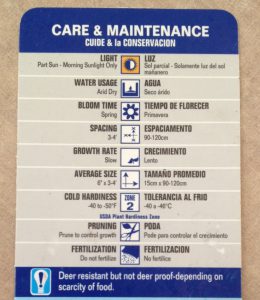
Typical plant tag. Notice the “Average Size” section. This is where consumers should use discretion.
So why does this happen? Why are plant tags so often mistaken? There are two primary reasons that correct mature sizes are not given. First, in the competitive world of plant breeding and introduction where there can be hundreds or thousands of cultivars of a single species, it is of utmost importance to introduce plants as quickly. Quick introduction is necessary because others are probably working to find similar traits; therefore, if one notices that a plant possesses a drastically different flower, flowering pattern, leaf shape, leaf size, or growth habit, the plant is often rushed to market. This leaves little time for complete trials of the plant to see what it would look like at maturity.
Secondly, most well-adapted or native trees/shrubs have relatively long life spans. A crapemyrtle or magnolia can easily grow and thrive in a landscape for thirty years or more before reaching maximum size. Nurseries simply do not have time to evaluate plants that long. Many nurseries, due to vagaries of economic cycles and length of career spans, don’t even exist for thirty years much less trial a single plant for that length of time!
In conclusion, nurseries are not likely to change their plant tag practices, but there are a couple of checks consumers can use to make sure they buy an appropriate plant for the scale of their site. First, it is a good rule of thumb to double the advertised plant height to arrive at a better idea of the plant’s mature size. Second, drive through established neighborhoods and observe what certain plants look like in a mature landscape. This will give one an idea of what the plant is capable of. The third and best option is to consult your local County Extension Office. They will be able to offer research-based information to help you make the right decision in your plant choices. Keep this in mind the next time you are thinking of buying the latest, greatest plant at your local nursery!
Happy Gardening!

by Matt Lollar | Oct 20, 2015
Warm and wet weather in the Florida Panhandle presents the optimum conditions for the development of bacterial gall on loropetalums. Shoot dieback is usually the first and most noticeable symptom of the disease. The dieback can be followed down the branch to dark colored, warty galls that vary in size. The galls enlarge and eventually encircle the branch resulting in branch or plant death. Olive, oleander, and ligustrum are also hosts for the bacteria that causes the galls, Pseudomonas savastanoi.
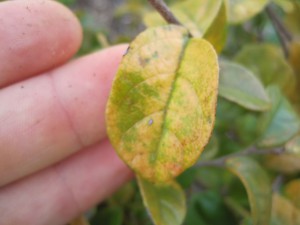
Dieback symptoms on loropetalum leaf from bacterial gall. Photo Credit: Matt Lollar, University of Florida/IFAS
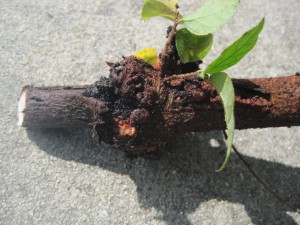
Bacterial gall on loropetalum. Photo Credit: Matt Lollar, University of Florida/IFAS
The most common source of bacterial gall is from the plant nursery. Prior to purchase, inspect plants for galls near the soil line. If plants have already been installed in the landscape, remove any branches containing galls. Pruning cuts should be made several inches below the gall. After each cut, dip pruners in a 10% bleach solution or spray with isopropyl alcohol to avoid spreading the disease to other parts of the plant or other plants. Prune during dry weather.
The best control for bacterial gall is selecting good quality plant material. For more information on this disease, please visit: Bacterial Gall on Loropetalum. More information on disease issues in the home landscape can be found at: Lawn and Garden Plant Diseases.
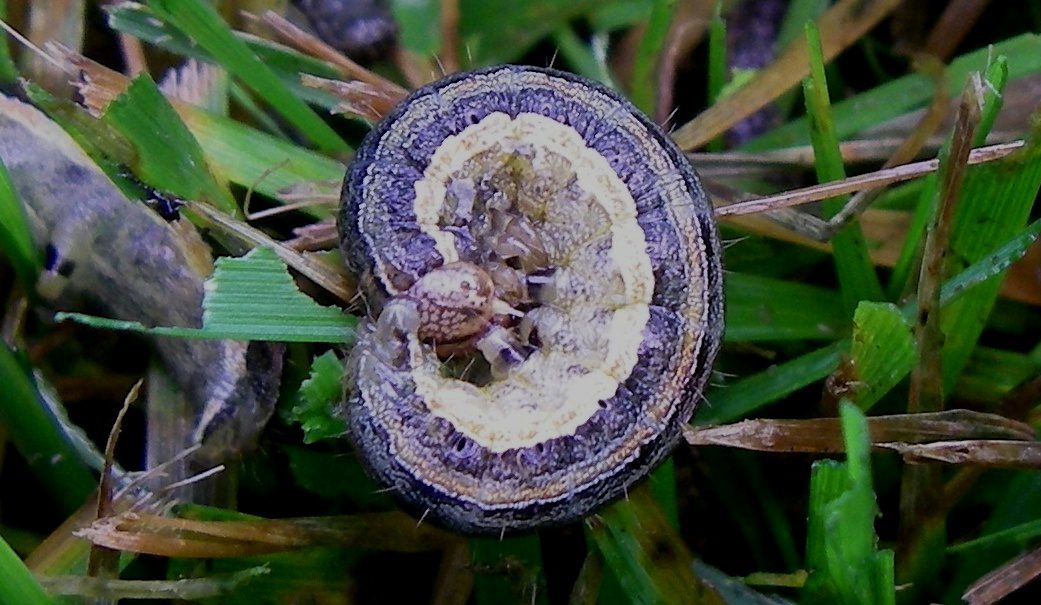
by Matt Lollar | Sep 23, 2015
Armyworms come in a wide range of colors and sizes. A few of the prominent species living in Florida are beet, southern, and fall armyworms. And the term “living” is not an exaggeration, because Florida is one of the lucky states where it is warm enough for armyworms to overwinter. They are the snowbirds that never leave!
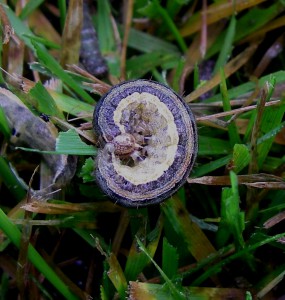
Armyworm damage on a lawn. Credit: Purdue University
Armyworms are notorious for unanticipated invasions. They feed on most turfgrass species and most vegetable crops, but they prefer grassy vegetable crops such as corn. Armyworms feed in large groups and their feeding has been described as “ground moving” in lawns. They feed during cooler times of the day (morning and evening) and they roll up and rest under the vegetative canopy (in the thatch layer in turf and in the base of leaves in vegetables) during the heat of the day.
Armyworms are difficult to control because of their spontaneity. However, in the lawn they hide in the thatch during the heat of the day. Over watering and fertilization can increase the amount of thatch. It is important to follow UF/IFAS guidelines for home lawn management. A good weed control program can also help to deter armyworms, because weeds serve as an alternate food source.
Numerous chemical control options are available, but softer chemicals such as horticultural oils and insecticides containing the bacteria Bacillus thuringiensis are recommended as a first line of defense. Insecticides should be applied in the morning or evening during feeding time. For additional control strategies and basic information please visit the UF/IFAS Armyworm Publication Page.
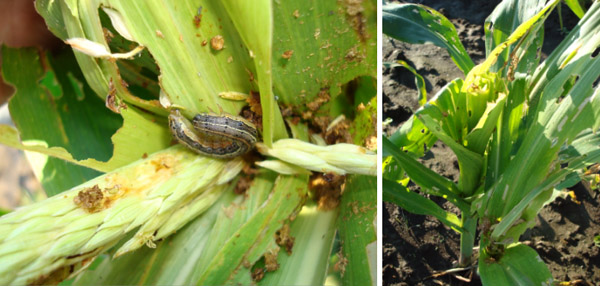
Armyworm feeding on a young corn plant. Credit: University of Illinois














